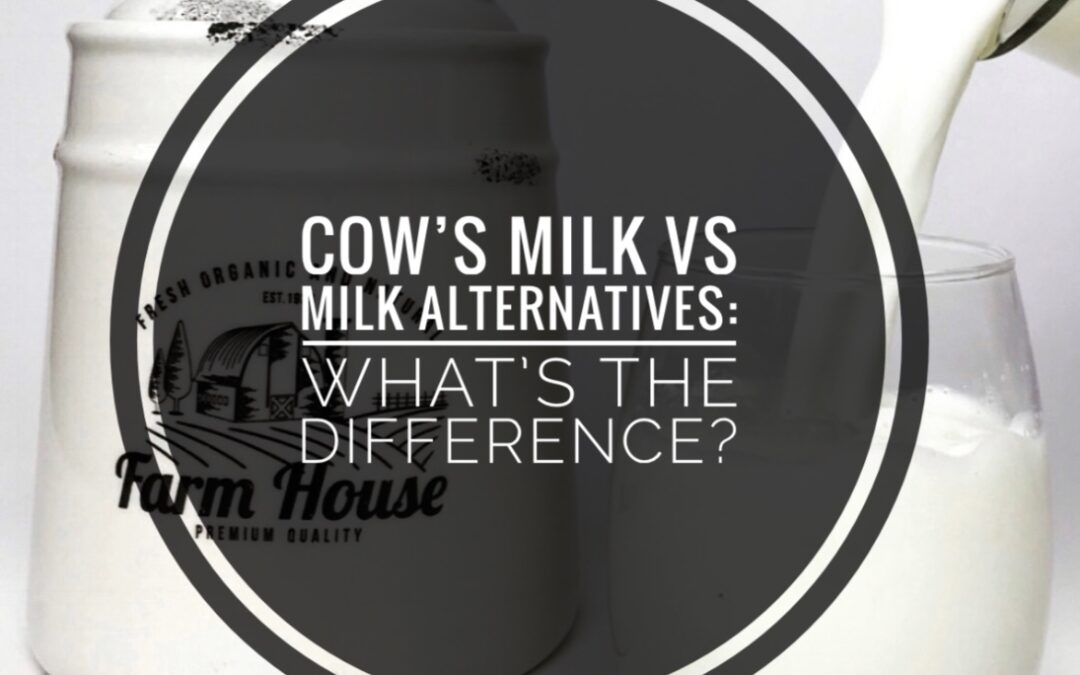Plant-based milks are becoming increasingly popular, but the nutritional benefits can be very different from traditional milk. Here’s how cow’s milk and milk alternatives are different.

Growing up, I had one option to pour over my cereal- skim milk. That’s what my parents bought, and therefore, that is what I used. It was that simple. Looking back, I’m so grateful. While I definitely didn’t grow-up eating a perfect diet, the nutrients I got through milk were exactly what I needed during my adolescent years, when my muscular system was rapidly developing and my bones were expanding and hardening.
Today, things are complicated! Store shelves are stocked with choices. You can find a wide variety of cow’s milk products, and also what are referred to as milk alternatives. All these choices have resulted in confusion over which one to buy. I hope to clear some confusion about the different types and share why I still say yes to the kind I was raised drinking.
What Is A Milk Alternative?
Milk alternatives come from plants that have been processed into a beverage, then marketed as an alternative to cow’s milk. Almond milk, rice milk, cashew milk and hemp milk are just a few examples of milk-alternatives. Because they have milk in the title, many assume they are nutritionally equal to cow’s milk, but that’s not the case. Most alternative milks are enriched with vitamins and minerals in an attempt to match the nutritional quality of cow’s milk as close as they can.

How Does Cow’s Milk Differ?
Cow’s milk, on the other hand, comes from you guessed it, cows! Like plant-based alternatives, cow’s milk is enriched with Vitamin D and Vitamin A. In cow’s milk, however, all other nutrients are naturally occurring. That’s why, when you compare the ingredient list on cow’s milk to that of plant-based alternatives, the cow’s milk list is way shorter. In fact, cow’s milk only has three ingredients, milk, vitamin D and Vitamin A. That’s it.
As a sports dietitian that works with young athletes, and as a mom of growing teens, I know first-hand how hard it can be to get high-quality nutrition into adolescents. Teens care about taste and convenience, while parents are concerned about cost and nutritional quality. That’s exactly what makes cow’s milk a great choice. Though is comes in a liquid form, it supplies the same nutrients you would get if you consumed a balanced meal. Just one-cup supplies 12 grams of carbohydrates, 8 grams of protein, 2.5 grams of fat, plus 9 other essential nutrients.
What Are The Differences Between Cow’s Milk And Plant-Based Milks?
There are three big differences in cow’s milk compared to plant-based varieties that I want to call out. They are: protein content, cost and convenience.
Protein
Though plant-based milk alternatives are enriched with vitamins and minerals, there is one key nutrient that they fail to provide; that nutrient is protein. While cow’s milk has 8 grams of protein per cup, almond milk, rice milk and coconut milk all have less than 1. It is the high-quality protein content of cow’s milk that makes it a big hit for growth and development, muscle recovery, satiety and meal balance.
Cost
High-quality protein can be expensive, but not if you source it from cow’s milk. The average cost of a half-gallon of cow’s milk is ~$2.05, compared to ~$3.35 /half gallon for milk alternative’s. Yes, you read that right—you pay more money for milk alternatives, but, get less of the most expensive nutrient- protein.
Convienience
Today’s families are busy and need quick, convenient ways to eat healthy on the go. Cow’s milk makes it easy. As I mentioned above, cow’s milk on its own is a balanced meal. And, you don’t have to be home to drink it. Cow’s milk can be found at your local convenience store, mini-mart, fast-food establishment and restaurants, making it easy to get balanced nutrition on the go.
Taste
Even if you don’t like milk alone, it’s a perfect way to add high-quality protein to your food. Boost the nutritional quality of your cereal, your smoothie, mashed potatoes or other recipes using cow’s mix as the liquid base.
You can compare the nutrients of cow’s milk versus pant-based varieties here.
Need a reason to believe? I’m sharing a super simply smoothie recipe to prove it. With just 4-ingredients, this Protein-Packed Pineapple Banana Smoothie is easy and inexpensive to make, highly nutritious and it tastes delicious. Give it a try and let me know what you think.


 Hi, I’m Heather – a registered dietitian, busy mom, consultant, adventure junkie and travel addict who has mastered living healthy on the go. My blog is where I share simple recipes and healthy living tips to help and inspire others to live their best life.
Hi, I’m Heather – a registered dietitian, busy mom, consultant, adventure junkie and travel addict who has mastered living healthy on the go. My blog is where I share simple recipes and healthy living tips to help and inspire others to live their best life.
I noticed you did not mention soy milk in this comparison. My 1 yo son has a dairy sensitivity and has been on soy-based formula since 6 months old (breastfed prior). With my lack of options, is soy milk comparable to cow’s milk when it comes to protein and nutrients?